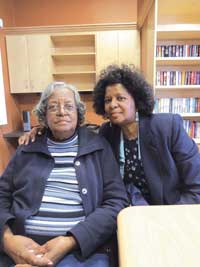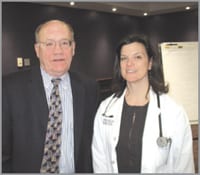PACE Setters – Fallon’s Summit ElderCare Sets a New Standard
Which means that she faces some significant challenges in her role as caregiver for her mother, Helese, who has several health issues, but is neither ready nor willing to move into a nursing home.
Pam told HCN that, as she launched a search for a solution to her dilemma, she did so with a specific mindset. She was looking for a facility that was a step above adult day care and two or three steps above a community senior center — a place where medical care was available in the form of an on-site geriatrician, but where there was also a strong social component with a host of activities for a diverse group of seniors.
She has found all this and a lot more at Summit ElderCare, a PACE (Program of All-inclusive Care for the Elderly) facility operated by Fallon Community Health Plan in Springfield’s North Medical District.
The facility, which opened its doors roughly a year ago, now serves 53 individuals with roughly the same needs as Helese. They are called ‘participants,’ rather than ‘clients,’ ‘patients,’ or ‘customers,’ because that term best describes what they are, said Kristine Bostek, vice president and executive director of Summit ElderCare.
Elaborating, she said they are participating in a program, based on a national model of coverage recognized by both Medicare and Medicaid, that provides medical care, geriatric case management, care coordination, adult day health services, full insurance coverage (including Medicare Part D prescription coverage), and in-home support in a personalized setting that features interaction with other seniors and a host of activities.
All of this resonated with Pam White.
“My mother is a very social person, and what appealed to me is that there would be other seniors involved in this program,” said White. “I wanted to engage my mother in a program where they have activities, and where it’s obviously a safe environment.
“It’s like one-stop shopping,” she went on, referring to the range of services offered at the facility. “They have a primary-care physician that specializes in geriatrics, and if my mother needs lab work, that can be done. And if I were trying to do that as caregiver, I’d be running here and running there, and that’s difficult with my work schedule.”
The Springfield location is one of five now operated by Summit ElderCare in Central and Western Mass., said Bostek, adding that the company started with a location in Worcester in 1995 and eventually added a second facility in that city before eventually expanding into Charlton and Leominster. Further expansion into the Merrimack Valley is now under consideration.
An assessment of the Western Mass. market several years ago revealed a need for a PACE facility there, said Bostek, noting that, after consideration of several possible landing spots, the company eventually chose a location in Springfield in a new medical building on Wason Avenue built to Fallon’s specifications.

One year after opening that site, the company is on target with regard to growth, said Mary Woodis, RN and site director, adding that this location will likely hit its goal of 250 participants within three years.
For this issue, HCN takes an in-depth look at Summit ElderCare’s Springfield facility and how it is improving the quality of life for both participants and their caregivers.
Senior Moments
Bostek told HCN that the PACE concept is gaining considerable traction across the country, with more than 100 sites currently operating nationwide.
Fallon is now the fifth-largest PACE provider in the nation, with 900 total participants, and the largest in New England, she said, adding that the company is a firm believer in this model of healthcare because it provides a viable option to more expensive nursing-home care, and will only become more popular as the population ages because of the many benefits it provides for people like Helese — and the peace of mind it offers to those like her daughter Pam.
The concept was described by both Bostek and Woodis as a “community-based alternative to nursing-home care,” and one with two critical elements: a healthcare component and a social component, which are both considered critical in the delivery of complete care to a participant.
Elaborating, Woodis said Summit ElderCare provides geriatric case management, care coordination, and a host of additional services that include:
• On-site medical care;
• 24/7 emergency access to a staff member;
• Physical and occupational therapy;
• Adult day services;
• Medically necessary supplies and equipment;
• In-home assistance;
• Medically necessary transportation;
• Nutritional counseling;
• Caregiver education and support; and
• Full medical and prescription drug coverage.
The model has met with a good deal of success in Central Mass., as evidenced by the steady base of expansion, said Bostek, adding that, by the start of this decade, the company was actively pursuing opportunities to bring the concept to other parts of the state.
“Based on experiences in Central Mass., we felt there was a huge opportunity to take this model into this part of the state,” she said of the Greater Springfield area. “So we embarked upon a plan to expand in Western Mass.”
The 14,500-square-foot Springfield facility is licensed to serve residents of Hampden County and a few communities in Hampshire County, said Woodis, adding that, while many of the current participants are from Springfield, several other communities are represented. To be eligible for the program, individuals must by 55 or older and meet clinical criteria that Bostek summed up with the phrase “nursing-home-eligible.”
The current mix of participants includes individuals across a broad age spectrum, said Woodis, adding that many are in their 60s, while a few are in their 90s, and there’s one centenarian. Some have cognitive issues, such as dementia or Alzheimer’s, while others do not, and there is a growing number of what would be considered younger seniors with neuromuscular disorders such as MS and ALS.
“A PACE participant, in general, is a frail, older adult,” said Dr. Alison Grover, the on-site gerontologist at the facility. “They probably average in their low 80s with multiple medical problems and usually some difficulty with mobility and self-care.
“It’s not at all unusual to have some level of memory impairment as well,” she went on, “and it’s our mission to keep such individuals in their home as opposed to in a nursing home.”
Summit Eldercare makes this possible by providing that one-stop shopping Pam White described.

Care Package
Elaborating on this concept, those we spoke with all used the phrase ‘integrated model of care’ to describe what’s offered, meaning both medical care and the many social aspects of the PACE program available at the Wason Avenue facility.
“People come here for their medical care,” said Bostek, referring to everything from visits with Grover to occupational and physical therapy. “But they’re also here for the social aspects of this program, doing things with other participants.”
It is this “complete package,” as Grover called it, that separates Summit ElderCare from a typical senior center and adult day care facilities, and also enables older adults to stay out of nursing homes.
Woodis said activities run the gamut from arts and crafts to computer classes; from reading in the facility’s small library to healthy-cooking classes. On the day HCN toured the facility, a Mother’s Day tea was in progress. Participants helped create tissue-paper flowers and also baked pies for the attendees.
The key to effectively providing this integrated model of care is teamwork, said Grover, and there are many members on the team, including nurses, physical and occupational therapists, a nutritionist, social workers, a transportation coordinator — who oversee work to get participants to and from appointments — and others.
Each day starts with a team meeting, she went on, one that essentially assesses the immediate needs of the participant population and creates an action plan.
“We talk about our participants — we talk about who may be having problems, who may be in or out of the hospital, who has a caregiver that’s been in the hospital for the past month,” she explained. “We talk about what we can do to help support the family and what the patient needs to be safe at home. We talk about whether we need to go out and see the patient at home that day. And then we go out and do our various jobs.”
This is an effective model, but one that many in this region don’t know about, said Bostek, adding that, to meet established goals for growth, the company must build awareness about the PACE concept. Meanwhile, it must also be diligent and imaginative when it comes to outreach and building relationships with individuals and agencies that might refer potential participants.
Those constituencies include senior centers and ASAPs (aging service access points), agencies that serve the elderly, as well as hospitals, primary-care physicians and specialists, elder-law attorneys, senior housing complexes, food pantries, and others.
“We really work hard to be very visible in locations where there would be a large older adult population, as well as a low-income older adult population,” said Bostek. “We do some marketing, but it’s really a grassroots approach that we take.
“You sit across the kitchen table from a caregiver and/or an older adult to talk about the program,” she went on. “We have that personalized touch, but we need to make sure that we’re out in the community and that we’re building relationships with community partners and resources, because we want to them to readily identify that this program may be a viable option for someone and refer them to us.”
Caregivers are a very important piece of this outreach process, Bostek continued, citing statistics showing that one in three Americans serve as caregiver to a spouse, older relative, or friend, and many, like White, face considerable challenges as they take on that assignment.
Grover agreed, and cited the caregiver of that aforementioned centenarian as a good example.
“That patient has medical problems and mild dementia, and is cared for by her son at home,” she explained. “In order to keep her there, he needs oversight on medical management, assistance in the home with personal care, and help to simply balance his caregiver role with other roles in his life. She needs help with personal care and mobility, and for someone like that, there aren’t many other alternatives.”
Coming of Age
There were not many alternatives for Pam White as she searched for a program that would allow her to keep working and also enable her mother to remain in her home and out of a skilled-nursing facility.
The program offered by Summit ElderCare has proven to be the solution sought by both mother and daughter, and this story is now being repeated on a regular basis at the Wason Avenue site.
These developments clearly show that the company has become a PACE setter, both literally and figuratively.



Comments are closed.